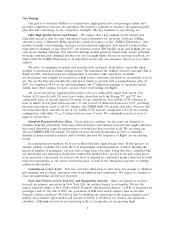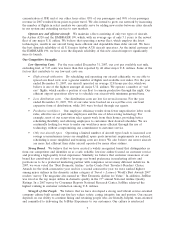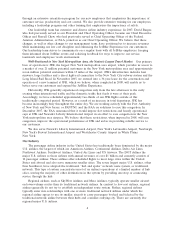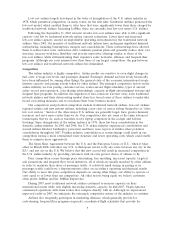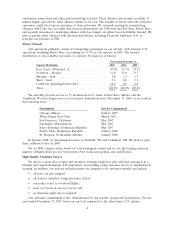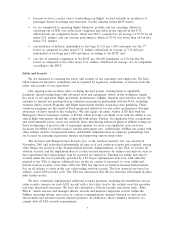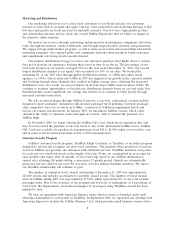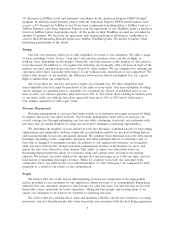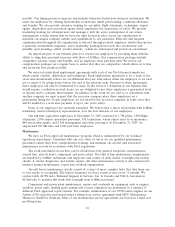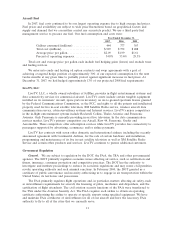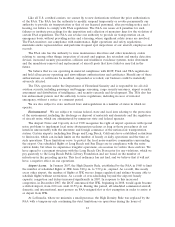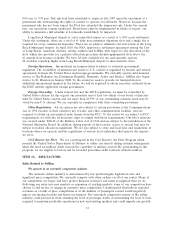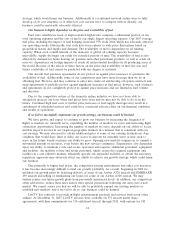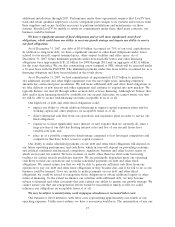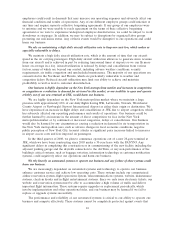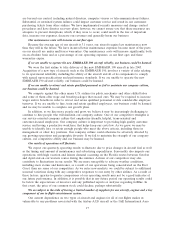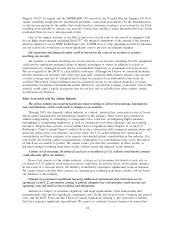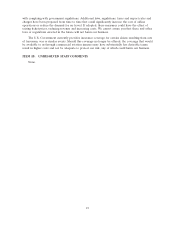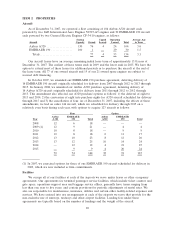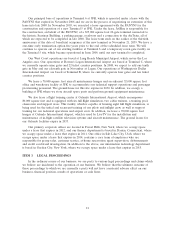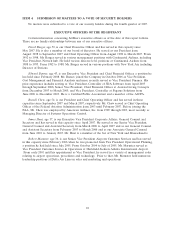JetBlue Airlines 2007 Annual Report Download - page 22
Download and view the complete annual report
Please find page 22 of the 2007 JetBlue Airlines annual report below. You can navigate through the pages in the report by either clicking on the pages listed below, or by using the keyword search tool below to find specific information within the annual report.Like all U.S. certified carriers, we cannot fly to new destinations without the prior authorization
of the FAA. The FAA has the authority to modify, suspend temporarily or revoke permanently our
authority to provide air transportation or that of our licensed personnel, after providing notice and a
hearing, for failure to comply with FAA regulations. The FAA can assess civil penalties for such
failures or institute proceedings for the imposition and collection of monetary fines for the violation of
certain FAA regulations. The FAA can revoke our authority to provide air transportation on an
emergency basis, without providing notice and a hearing, where significant safety issues are involved.
The FAA monitors our compliance with maintenance, flight operations and safety regulations,
maintains onsite representatives and performs frequent spot inspections of our aircraft, employees and
records.
The FAA also has the authority to issue maintenance directives and other mandatory orders
relating to, among other things, inspection of aircraft and engines, fire retardant and smoke detection
devices, increased security precautions, collision and windshear avoidance systems, noise abatement
and the mandatory removal and replacement of aircraft parts that have failed or may fail in the
future.
We believe that we are operating in material compliance with DOT, FAA and TSA regulations
and hold all necessary operating and airworthiness authorizations and certificates. Should any of these
authorizations or certificates be modified, suspended or revoked, our business could be materially
adversely affected.
The TSA operates under the Department of Homeland Security and is responsible for all civil
aviation security, including passenger and baggage screening, cargo security measures, airport security,
assessment and distribution of intelligence, and security research and development. The TSA also has
law enforcement powers and the authority to issue regulations, including in cases of national
emergency, without a notice or comment period.
We are also subject to state and local laws and regulations in a number of states in which we
operate.
Environmental. We are subject to various federal, state and local laws relating to the protection
of the environment, including the discharge or disposal of materials and chemicals and the regulation
of aircraft noise, which are administered by numerous state and federal agencies.
The Airport Noise and Capacity Act of 1990 recognizes the right of airport operators with special
noise problems to implement local noise abatement procedures as long as those procedures do not
interfere unreasonably with the interstate and foreign commerce of the national air transportation
system. Certain airports, including San Diego and Long Beach, California have established restrictions
to limit noise, which can include limits on the number of hourly or daily operations and the time of
such operations. These limitations serve to protect the local noise-sensitive communities surrounding
the airport. Our scheduled flights at Long Beach and San Diego are in compliance with the noise
curfew limits, but when we experience irregular operations, on occasion we violate these curfews. We
have agreed to a payment structure with the Long Beach City Prosecutor for any violations, which we
pay quarterly to the Long Beach Public Library Foundation and are based on the number of
infractions in the preceding quarter. This local ordinance has not had, and we believe that it will not
have, a negative effect on our operations.
Airport Access. In January 2007, the High Density Rule, established by the FAA in 1968 to limit
the number of scheduled flights at JFK from 3:00 p.m. to 7:59 p.m., expired. As a result, like nearly
every other airport, the number of flights at JFK was no longer regulated and airlines became able to
schedule flights without restrictions. As a result of over-scheduling beyond the airport’s hourly
capacity, congestion and delays increased significantly in 2007. In response to this increased
congestion, in December 2007, the DOT announced that JFK, beginning in 2008, would again become
a slotted airport, from 6:00 a.m. until 10:59 p.m. During this period, all scheduled commercial aircraft,
domestic and international, must possess an FAA-assigned slot or slot exemption in order to arrive at
or depart from JFK.
At LaGuardia, where we maintain a small presence, the High Density Rule was replaced by the
FAA with a temporary rule continuing the strict limitations on operations during the hours of
12


